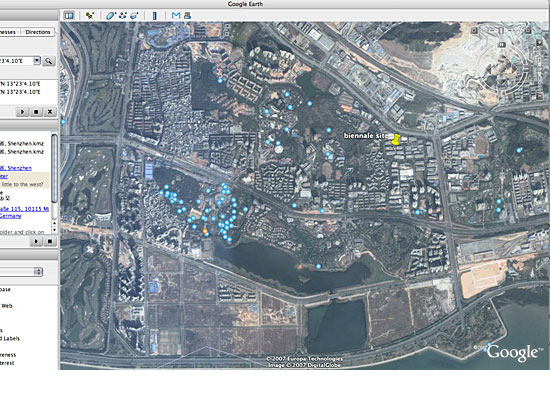总站 :: DEAD END > OFF SIGHT
Second Shenzhen and Hong Kong Bi-city Biennale of Urbanism & Architecture 2007
December 8-15, Shenzhen, CN

all Shenzhen photos from BAO Atelier
Guy Debord once said that “everything directly lived has moved into representation.” What we experience first-hand, we’ve already learned about second-hand. What we know as real, what we feel is authentic is but an after-image, a format of reality mediated by the very world we build around us. So thorough has been our mediation globally that different places across the globe begin to seem oddly similar. At a glance, you’re in Paris, look closer and you’re in Shenzhen, close your eyes and its Cairo. With 30 minutes of Shenzhen, we will bring you through, above, and around the world – what does the world look like from Shenzhen and what does Shenzhen look like from a distance? In the next 30 minutes, your surroundings may seem present, distant, dissolved, surreal, and strangely familiar. Welcome to your window to the world.
The experience
The ideas that we aim to fold together in this pedicab experience are related to our perceived ability to define an urban experience in Shenzhen while situated in Berlin. How does one understand and design an experience for a distant physical location without being there? According to the American historian, Anthony Grafton, “ninety-five per cent of all scholarly inquiries start at Google.”
Google, and its subsidiary, Google Earth, has constructed for us a massive architectural feat – a tunnel linking Shenzhen to Berlin, trafficking information in the form of live and archived sound, images, video and text. Distance is no longer perceived, and through this tunnel, we experience a digitized version of Shenzhen – Shenzhen 2.0, perhaps.
The passenger on the pedicab will be given a cell-phone, and throughout the trip, strangers from around the world will call, offering bits of information that was found while Google-searching “Shenzhen.” Tourist information, financial stat-sheets, blog entries and all other manner or information will be conveyed as stories, rumors and hearsay – providing, in effect, a parallel or live experience of the randomized data that one receives on Google’s searches. The stranger may also engage the rider in conversation: “What do you see now?” “Are you cold?” This conflation of distances and information with a live urban experience will culminate at the surreal gates of Window of the World, a theme park close to the Biennale site that similarly fuse these criteria, illustrating the surreal, dislocating effects of our contemporary world.
PROGRAM was invited by Bao Atelier (Beijing) to participate at 总站 :: DEAD END during the Second Shenzhen and Hong Kong Bi-city Biennale of Urbanism & Architecture 2007.
总站 :: DEAD END is predicated on the disconcerting experience of urban destinations as increasingly orchestrated spectacles, dissimulating participation, observation and accumulation in “pictorialized time/space” resorts (M.Christine Boyer).
By sustaining a re-edification of the imagination of space as a form of self-generated narration and discovery, 总站 :: DEAD END attempts at provoking experience in the moment of a “lasting impression”, one that discards actual familiarity with the city and fabricates unmediated itineraries as an open end.
These artist-created journeys will provide possible, multimedia impressions of the city of Shenzhen for the visitors of the biennale exiting the main venue, articulating along pathways that might have already encountered expiration by means of destruction, relocation, interruption, being thus unresponsive-to yet alternatively regenerating the imagery created by media and information technologies.
(from Bao Atelier 总站 :: DEAD END project description)
Collaborators: Mary Chiu, Liu Xiao
Special thanks to: Joshua Kauffman, Gwendolyn Floyd, Kari Rittenbach, Elaine W. Ho